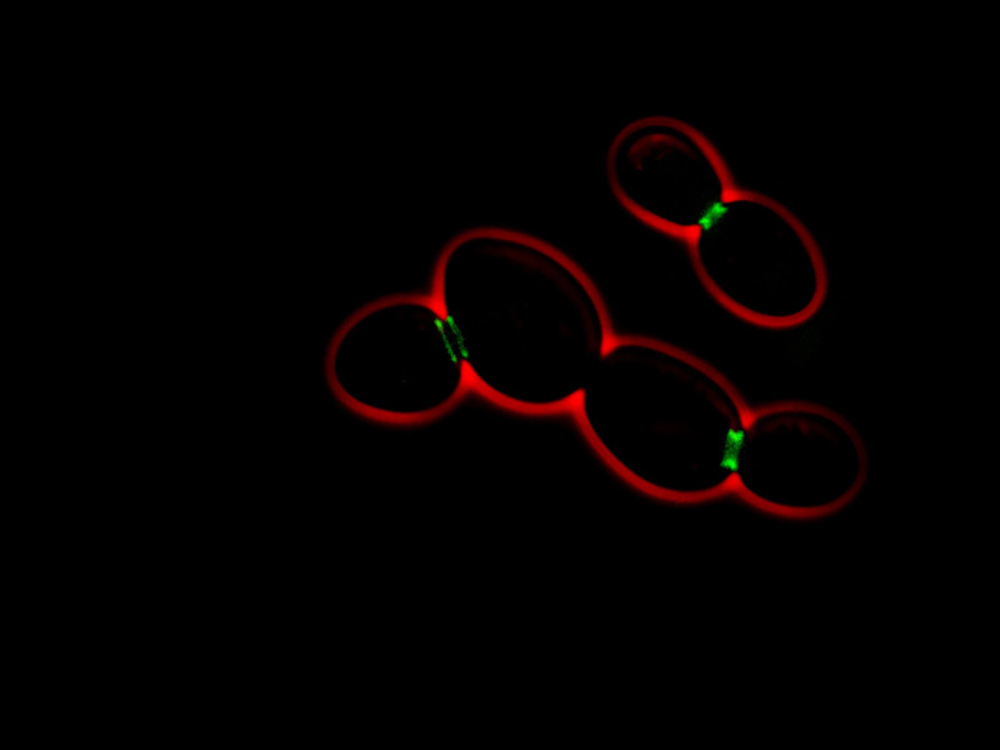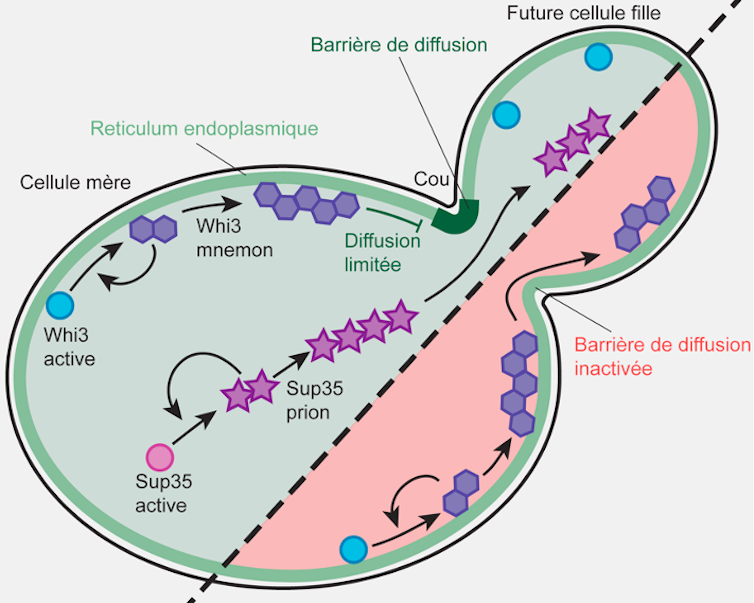Mnemons: memory through prion proteins
Just as we are able to store information, single-cell organisms can retain memories of past stresses. This enables these simple cells to better respond to the same stress in the future - and thus, for example, ensure the survival of the colony.
Caudron Fabrice, University of Montpellier

But how are these memories formed at the molecular level? Can these mechanisms teach us more about the very foundations of memory, even in human beings? Or even help us better understand the mechanisms of certain diseases?
To find out more, we looked at a memory process present in the baker's yeast, Saccharomyces cerevisiae. Here are the results of our work, just published in the journal Current Biology.
Sex and memory in baker's yeast
Saccharomyces cerevisiae is a fairly simple organism: made up of a single cell with a nucleus (like human cells and unlike bacteria), it reproduces vegetatively, i.e. its cell forms a bud on the surface which becomes the future daughter cell.
However, S. cerevisiae can also reproduce sexually. To identify a potential sexual partner, yeast secrete and detect specific chemicals: sex pheromones. When two yeasts of the opposite sexual type find themselves in close proximity, they stop their vegetative reproduction and grow a cytoplasmic projection (the cytoplasm being the "body" of the cell, the part surrounding the nucleus), called a "shmoo", towards their consort.
Since yeast can't move, they elongate towards each other until they meet and fuse into a new individual in which their genomes mix. This increases their genetic diversity.
But this commitment to sexual reproduction is a costly, if not risky, decision. For example, one can imagine two cells of the same sexual type courting a single cell of the opposite type. One of these two cells would not be able to fuse with its presumptive partner and would therefore have produced a shmoo for nothing... Fortunately, yeast can "choose" not to respond to the pheromone - a refusal which they will then retain in their memory for a long time to come.
Once a yeast no longer responds to the pheromone, it's gone for good. It will then only reproduce vegetatively. On the other hand, its future daughter cells are born "naïve": they do not inherit their mother's memory, and are capable of reacting to any sex pheromone present in their environment.
How does the memory of a single-cell organism work?
The key to S. cerevisiae 's memory is the Whi3 protein. By changing its conformation (the way it folds in three dimensions), Whi3 becomes inactive, enabling the cell to ignore the pheromone.
We have been able to observe that this Whi3 protein behaves rather like a prion - a pathogenic protein due to its abnormal 3D folding, and often contagious. Prion-like proteins were first identified in the 1980s by the American neurologist Stanley Prusiner, notably in the wake of the mad cow crisis: he demonstrated that by changing its three-dimensional conformation, the Prion protein becomes pathogenic and contagious, causing not only pathology in cattle, but also Creutzfeldt-Jakob disease in our own species.
Returning to yeast, Whi3's conformational change is self-replicating, meaning that it is transmitted from an abnormal protein to a normal protein (which it "contaminates") by simple contact, to form aggregates. This self-replicating phenomenon for encoding memory is interesting, as it implies that the new conformation of its Whi3 protein can be inscribed in time by being transmitted, and remain stable.
However, a major problem remains: how can the mother cell ensure that "its memory" won't invade its daughter cell?
Understanding this form of physical memory
Yeast is home to many types of prion protein, most of which, once formed, are passed on to the daughter cell. However, this is not the case with Whi3, which is what makes it so unique.
Using yeast genetics and microscopy, we compared the best-understood yeast prion, named Sup35 (the translation termination factor), with Whi3.
We've already discovered that Whi3 associates with the membranes of the endoplasmic reticulum (a huge networked sac where the cell assembles its proteins). But also that, in this reticulum, barriers were set up between the mother cell and the elements of its future daughter cell - thus enabling the retention of Whi3 from the progenitor.
Genetic removal of the diffusion barriers transforms Whi3 into a "true" prion, which can spread to daughter cells. The containment of Whi3 and the memory encoded by this protein are lost. On the other hand, the spread of the Sup35 prion, which does not bind specifically to the endoplasmic reticulum, is not influenced by the diffusion barrier.

Fabrice Caudron, Provided by the author
A step towards a better understanding of cellular memories
This study highlights that the association of prion-like proteins with membranes, and the compartmentalization of these membranes by diffusion barriers, together constitute a powerful mechanism for the formation of long-term epigenetic (i.e. non-DNA-coded) cellular memories. These "memories" may be confined to a sub-compartment of the cell, in this case the dividing mother cell.
The Whi3 protein, although very similar to prions, is therefore considered a "mnemon": a particular type of prion that is kept under control and encodes a memory. But what does this have to do with neuronal memory, the kind at work in our brains?
It turns out that a protein important for neuronal memory, for example during the memorization of sexual disappointments in Drosophila flies, depends on the prion-like behavior of the CPEB protein in the synapse, the connection point between two neurons.
We hypothesize that in Drosophila, CPEB is also a mnemon, confined to the synapse activated during memory formation. This confinement would prevent the CPEB protein from diffusing into neighboring synapses of the same neuron (which could activate them erratically and compromise memory formation).
In Homo sapiens, the CPEB3 protein has the same characteristics as the Drosophila CPEB: it may behave like a prion, or more likely, a mnemon. These similarities imply that the foundations of memory, at the cellular level, have a long evolutionary history...
These results and hypotheses raise the question as to whether neurodegenerative diseases associated with prions and protein aggregates are not sometimes due to defects in cellular confinement. We know, for example, that these barriers are less effective in the stem cells of aged mice. Could we then try to restore them, in order to limit the spread of prion-type proteins?
It's still a theoretical avenue, but one that opens up many new prospects...![]()
Caudron Fabrice, Team leader, cell biology, yeast genetics, asymmetric cell division, cell memory, University of Montpellier
This article is republished from The Conversation under a Creative Commons license. Read theoriginal article.